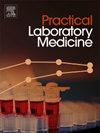Comparative evaluation of four new immunoassays and LC-MS/MS for the measurement of urinary free cortisol in Cushing's syndrome diagnosis
IF 1.3
Q3 MEDICAL LABORATORY TECHNOLOGY
引用次数: 0
Abstract
Objectives
Twenty-four-hour urinary free cortisol (UFC) measurement is the initial diagnostic test for Cushing's syndrome (CS). We compared UFC determination by four new immunoassays using Autobio A6200, Mindray CL-1200i, Snibe MAGLUMI X8 and Roche 8000 e801 with liquid chromatography-tandem mass spectrometry (LC-MS/MS). Additionally, we evaluated the value of 24-h UFC measured by four direct immunoassays for diagnosing CS.
Methods
Residual 24-hr urine samples of 94 CS and 243 non-CS patients collected from previous cohort were used. A laboratory-developed LC-MS/MS method was used as reference. UFC was measured by immunoassays using Autobio, Mindray, Snibe and Roche platforms. Method was compared using Passing–Bablok regression and Bland–Altman plot analyses. Cut-off values for each assay and corresponding sensitivities and specificities were calculated by ROC analysis.
Results
All four immunoassays showed strong correlations with LC-MS/MS (Spearman coefficient r = 0.950, 0.998, 0.967, and 0.951, respectively). All immunoassays showed proportionally positive bias. The areas under the curve were 0.953 for Autobio, 0.969 for Mindray, 0.963 for Snibe, and 0.958 for Roche. The cut-off values varied from 178.5 to 272.0 nmol/24 h). Assay sensitivity and specificity ranged from 89.66 % to 93.10 % and from 93.33 % to 96.67 %, respectively.
Conclusions
Four newly available direct immunoassays for measuring UFC show good analytical consistency compared to LC-MS/MS. The elimination of organic solvent extraction simplifies workflows while maintaining high diagnostic accuracy. Additionally, they exhibited similarly high diagnostic accuracy for CS identification. Future multi-center studies are needed to validate our findings and establish method-specific UFC cut-off values to enhance clinical utility.
四种新型免疫测定法与LC-MS/MS测定尿游离皮质醇在库欣综合征诊断中的比较评价
目的:24小时尿游离皮质醇(UFC)测定是库欣综合征(CS)的初步诊断指标。我们比较了使用Autobio A6200、迈瑞CL-1200i、Snibe MAGLUMI X8和罗氏8000 e801的四种新型免疫分析法的液相色谱-串联质谱(LC-MS/MS)对UFC的测定。此外,我们评估了通过四种直接免疫分析法测量的24小时UFC对诊断CS的价值。方法采用既往队列收集的94例CS和243例非CS患者的24小时残尿样本。以实验室建立的LC-MS/MS方法为参照。使用Autobio、Mindray、Snibe和Roche平台进行免疫测定UFC。方法采用Passing-Bablok回归和Bland-Altman图分析进行比较。通过ROC分析计算每个检测的截止值以及相应的灵敏度和特异性。结果4种免疫分析法与LC-MS/MS均具有较强的相关性(Spearman系数r分别为0.950、0.998、0.967、0.951)。所有免疫分析均显示成比例的阳性偏倚。Autobio的曲线下面积为0.953,Mindray为0.969,Snibe为0.963,Roche为0.958。临界值为178.5 ~ 272.0 nmol/24 h)。检测灵敏度和特异度分别为89.66% ~ 93.10%和93.33% ~ 96.67%。结论与LC-MS/MS相比,新建立的4种直接免疫检测方法具有良好的分析一致性。消除有机溶剂萃取简化了工作流程,同时保持了高诊断准确性。此外,它们在CS识别方面表现出类似的高诊断准确性。未来的多中心研究需要验证我们的发现,并建立特定方法的UFC临界值,以提高临床实用性。
本文章由计算机程序翻译,如有差异,请以英文原文为准。
求助全文
约1分钟内获得全文
求助全文
来源期刊

Practical Laboratory Medicine
Health Professions-Radiological and Ultrasound Technology
CiteScore
3.50
自引率
0.00%
发文量
40
审稿时长
7 weeks
期刊介绍:
Practical Laboratory Medicine is a high-quality, peer-reviewed, international open-access journal publishing original research, new methods and critical evaluations, case reports and short papers in the fields of clinical chemistry and laboratory medicine. The objective of the journal is to provide practical information of immediate relevance to workers in clinical laboratories. The primary scope of the journal covers clinical chemistry, hematology, molecular biology and genetics relevant to laboratory medicine, microbiology, immunology, therapeutic drug monitoring and toxicology, laboratory management and informatics. We welcome papers which describe critical evaluations of biomarkers and their role in the diagnosis and treatment of clinically significant disease, validation of commercial and in-house IVD methods, method comparisons, interference reports, the development of new reagents and reference materials, reference range studies and regulatory compliance reports. Manuscripts describing the development of new methods applicable to laboratory medicine (including point-of-care testing) are particularly encouraged, even if preliminary or small scale.
 求助内容:
求助内容: 应助结果提醒方式:
应助结果提醒方式:


